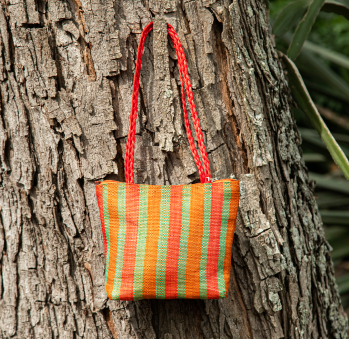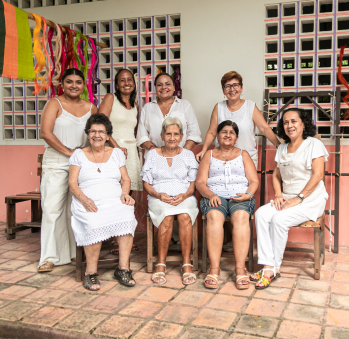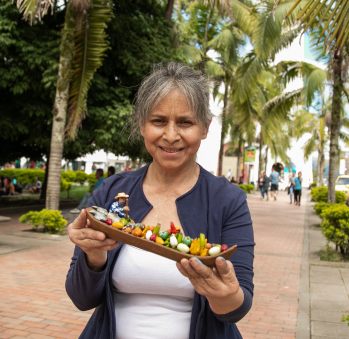Angélica Cruz
Workshop: Artefique
Craft: https://www.google.com/maps?cid=3745456864916474917
Trail: Huila Route
Location: La Jagua, Huila
SCHEDULE YOUR VISIT
Carrera 3 # 7-20 San Francisco, Centro Poblado de La Jagua, Huila
3112883851
artefiquelajagua@gmail.com
@artefiquelajagua
@ArtefiqueLaJagua
Imagine growing up in an enchanted town, surrounded by weavers and stories of chatty witches. Imagine being raised observing these wise and closely-knit women transform agave into thread using their enchanted spindles, all while learning that for every illness there’s a healing herb. This was the upbringing of Angélica Cruz surrounded by craftswomen. Her mother, Luz Marina Trujillo, was one of the five founding members of Artefique, an association established in 1991. The other founding members were Cruz Elena Fernández, Melba Polo Trujillo, Maria Betty Naranjo, and Rosario Torres. From the initial group of sixty women, after some left or passed away, only ten remain today. Together, they have shaped the essence of what Artefique represents today.
Traditionally, women in La Jauga used to weave bags such as the pizarrero, a large bag that children used to carry their slate chalkboards to school when notebooks weren’t yet common. They also made ropero bags for their husbands, who carried a change of clothes in them while working in their plantain fields across the Magdalena River. Then there were the aguardientero bags, perfectly sized to hold a bottle of Doble Anís, the region’s local hard liquor. These petite bags were ideal for the San Pedro festival, the major celebration of Huila, held in late June. Following their tradition, the members of Artefique primarily weave bags. The women comprising the group are Luz Marina Trujillo, Judith Trujillo, Melba Polo, María Gutiérrez and her daughter Nora Cuéllar, Cruz Elena Fernández, María Betty Naranjo, Beatriz Quintero, Rosario Torres, and Angélica Cruz.
From the outset, their looms have been stationed at the organization’s headquarters, where they work collaboratively. This is where they gather fibers, harvested from living fences of nearby coffee farms. Once the fibers are obtained, they wash and dye them using anilines or local plants familiar to them, like achiote, coca leaves, diamante tree bark, tea, and onions. After the fibers are dried, they are either tied onto the looms or spun. They specially care for the spinning process. The quality and uniformity of the threads depend on how skillfully they manipulate their enchanted spindles. The spindles are crafted by the artisans from bamboo sticks and pieces of tire or wood. Whether the spindle is heavy or light, made of tire or wood, varies for each artisan based on their personal working style. Some spin the spindle in the air, while others rest it on a stool—for it to rattle as it spins. Once the threads are prepared, they are woven into a variety of bags.
However, the group faced a significant loss in 2022 when Marta Cecilia Trujillo, one of its members, passed away. Angélica describes her as the most skilled artisan, often chosen for crafting the most special pieces. As a child, Angélica would assist Marta and her mother in cutting the threads of their finished products after returning from school. Marta taught her the art of weaving. Coping with her absence has been challenging for the entire group. In honor of Marta’s legacy, Angélica has made a promise to make her legacy transcend. Her goal is to inspire Marta’s daughters, Ivonne and María Camila, to become part of the group. This commitment aligns with their motto, “”Threading lives, weaving stories.””
Angélica herself experienced this transformative journey. After obtaining a Design degree in Barranquilla, the distance from her hometown prompted her to reflect on and value her roots. In 2018, she returned to La Jagua. Since then, she has worked closely with these artisans whom she deeply admires and respects. She encourages them to initiate new projects and apply for opportunities to keep their tradition alive and relevant. During the pandemic, their strong bond led to the development of a project inviting tourists to witness the entire process surrounding their material, fique. Participants of this project have the chance to observe firsthand the whole process behind their products. We invite you to visit them and come across the aloes they have cultivated at Artefique, and to learn about the cutting, extraction, dyeing, and combing of the fibers. Instead of combs, they employ the side of their hands to “”smack”” the fibers. The journey concludes with watching them spin and weave using their macanas (sticks made from chonta wood, used for tightening threads during weaving). This experience offers insight into the value and magic that underlie their remarkable work.
Craft






















Artisans along the way
Artisans along the way
No puede copiar contenido de esta página




























































